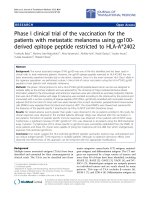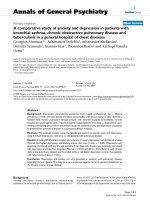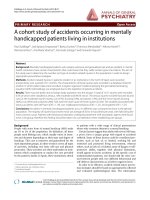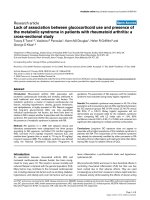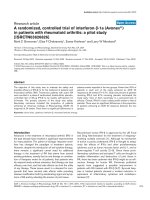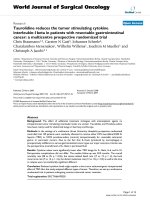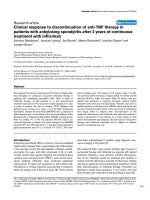Báo cáo y học: "β A randomized, controlled trial of interferon-β-1a (Avonex®) in patients with rheumatoid arthritis: a pilot study [ISRCTN03626626]" pptx
Bạn đang xem bản rút gọn của tài liệu. Xem và tải ngay bản đầy đủ của tài liệu tại đây (58.03 KB, 5 trang )
Introduction
Advances in the treatment of rheumatoid arthritis (RA) in
the past decade have resulted in significant improvements
for many patients. The advent of biologic response modi-
fiers has changed the paradigm of treatment options.
However, despite the introduction of anti-cytokine therapy,
there remains a significant unmet need for additional
therapy in the treatment of RA that stems from several
existing problems, namely that no one therapy or combina-
tion of therapies works for all patients, that patients who
do respond rarely achieve remission, that therapy can lose
efficacy over time, and that side effects can limit the utility
of any therapy. These issues result in a demand for com-
pounds that have minimal side effects while providing
disease modification both by ameliorating signs and symp-
toms of RA and by retarding the erosion of joint tissue.
Recombinant human IFN-β is approved by the US Food
and Drug Administration for the treatment of relapsing–
remitting multiple sclerosis [1]. Although its mechanism
of action is poorly understood, IFN-β is thought to antag-
onize the effects of IFN-γ and other proinflammatory
cytokines, such as tumor necrosis factor and IL-1, and to
down-regulate T-cell activity [2–5]. Since these proin-
flammatory cytokines and activated T cells are thought to
mediate inflammation and destruction of joint tissue in
RA, there has been optimism that IFN-β might be an effi-
cacious therapy for human RA. Previously published
reports have suggested a possible improvement in
patients with RA treated with IFN-β [6,7]. Synovial biop-
sies in treated patients showed a modest reduction in
expression of inflammatory cytokines and metallopro-
teinases [7].
ACR = American College of Rheumatology; ACR 20 (50, 70) = 20% (50%, 70%) improvement relative to baseline, according to ACR criteria;
DMARD = disease-modifying antirheumatic drug; IFN = interferon; IL = interleukin; ITT = intention to treat; RA = rheumatoid arthritis.
Available online />Research article
A randomized, controlled trial of interferon-
ββ
-1a (Avonex
®
)
in patients with rheumatoid arthritis: a pilot study
[ISRCTN03626626]
Mark C Genovese
1
, Eliza F Chakravarty
1
, Eswar Krishnan
1
and Larry W Moreland
2
1
Division of Immunology and Rheumatology, Stanford University, Palo Alto, CA, USA
2
Division of Rheumatology, University of Alabama at Birmingham, Birmingham, AL, USA
Corresponding author: Mark C Genovese (e-mail: )
Received: 24 Sep 2003 Revisions requested: 16 Oct 2003 Revisions received: 17 Oct 2003 Accepted: 23 Oct 2003 Published: 7 Nov 2003
Arthritis Res Ther 2004, 6:R73-R77 (DOI 10.1186/ar1026)
© 2004 Genovese et al., licensee BioMed Central Ltd (Print ISSN 1478-6354; Online ISSN 1478-6362). This is an Open Access article: verbatim
copying and redistribution of this article are permitted in all media for any purpose, provided this notice is preserved along with the article's original
URL.
Abstract
The objective of this study was to evaluate the safety and
possible efficacy of IFN-β-1a for the treatment of patients with
rheumatoid arthritis (RA). Twenty-two patients with active RA
were enrolled in a phase II randomized, double-blind, placebo-
controlled trial of 30 µg IFN-β-1a by weekly self-injection for
24 weeks. The primary outcome of the study was safety.
Secondary outcomes included the proportion of patients
achieving an American College of Rheumatology (ACR) 20
response at 24 weeks. There were no significant differences in
adverse events reported in the two groups. Fewer than 20% of
patients in each arm of the study achieved an ACR 20
response at 24 weeks (P = 0.71). Sixty-nine percent of patients
receiving IFN-β and 67% receiving placebo terminated the
study early, most of them secondary to a perceived lack of
efficacy. Overall, IFN-β-1a had a safety profile similar to that of
placebo. There were no significant differences in the proportion
of patients achieving an ACR 20 response between the two
groups.
Keywords: clinical trials, cytokines, interferon-β, rheumatoid arthritis, therapy
Open Access
R73
R74
Arthritis Research & Therapy Vol 6 No 1 Genovese et al.
We report a 24-week randomized, double-blind, placebo-
controlled study of the use of IFN-β-1a (Avonex
®
) in
patients with RA. The primary objective of the study was
to evaluate the safety of its weekly administration. Sec-
ondary objectives included the evaluation of its potential
efficacy in patients with RA who have active disease
despite treatment with available disease-modifying
antirheumatic drugs (DMARDs).
Materials and methods
This study was approved by the investigational review
board at each participating institution. The study subjects
were men or women at least 18 years of age with RA
defined by the American College of Rheumatology (ACR)
criteria [8]. All patients had failed at least one currently
available DMARD or biologic response modifier and had
active RA with more than six swollen and six tender joints
at the time of enrollment. Patients were allowed to be
receiving the following background DMARDS, if any, as
long as the doses were stable for at least 2 months before
enrollment: methotrexate, sulfasalazine, and hydroxy-
chloroquine either as monotherapy or in combination.
Patients taking up to 10 mg prednisone daily and/or nons-
teroidal anti-inflammatory drugs were allowed to partici-
pate if the dose had been stable for 28 days before the
screening visit. All patients gave their written, informed
consent prior to participation. Exclusion criteria included a
history of malignancy within the past 5 years, a history of
seizure disorder, and a positive test for HIV, hepatitis B, or
hepatitis C. Patients could be excluded for active psychi-
atric disease, major organ dysfunction, or serious local or
systemic infection. Female patients were excluded if they
were pregnant, breastfeeding, or unwilling to use an ade-
quate method of contraception.
Treatments
Patients were randomized to receive IFN-β-1a (30 µg intra-
muscular weekly) or matched placebo in a 3:1 ratio at each
of two sites (Stanford University and the University of
Alabama at Birmingham). The standard dose of 30 µg was
chosen based upon its known profile in the treatment of
multiple sclerosis. All study personnel at both sites
remained blinded to the randomization schedule. The study
drug and matched placebo were provided in blinded
fashion and were labeled with the patient’s name and ran-
domization number. Physician’s visits were scheduled
monthly. Patients who completed the study were seen again
4 weeks after the 24th injection (28 weeks) for a final visit.
Safety evaluation
Adverse events and safety issues pertaining to the use of
IFN-β were carefully monitored during the study.
Evaluation of efficacy
The primary efficacy end point of the study was a 20%
improvement in ACR criteria from baseline to week 24 [9].
The secondary end points were the proportion of patients
achieving a 50% or 70% ACR response at week 24.
Statistical methods
The differences between the randomization groups were
evaluated by Student’s t-test (for differences in means)
and chi-square test and Fisher’s exact test (for differences
in proportions). Analysis of safety end points included all
patients who received at least one injection of placebo or
study drug. Differences in adverse events between the
placebo and interferon groups were analyzed using Fish-
er’s exact test. The primary analysis of efficacy end points
was based on an intention-to-treat (ITT) approach. All
patients were analyzed according to their randomization
category. Those whose ACR response status could not
be ascertained because of a missing evaluation were con-
sidered nonresponders for the relevant time point. The
primary analysis of the ACR response rates at week 24
was based on Fisher’s exact test. A one-tailed α level of
0.05 was used for defining statistical significance.
Results
Although the target accrual for the study was 40 patients,
the total number of patients screened was 25, with 22
patients enrolled (11 at each site) over a period of
12 months. The anticipated accrual numbers were not
achieved because of difficulty recruiting. This difficulty
stemmed from the availability of other therapies approved
by the US Food and Drug Administration, the availability of
other investigational therapies, and patients’ reluctance to
give themselves intramuscular injections.
The baseline demographics for this cohort were similar to
those of other previously published clinical trials [10,11].
Patients in the IFN-β-1a treatment arm and the placebo
arm were well matched for baseline characteristics
(Table 1), with the exception of a statistically significant
larger percentage of patients on background DMARDs in
the IFN-β-1a treatment arm (81%) than in the placebo arm
(33%). The majority (15/22; 68%) of patients in this study
were on background DMARDs, with methotrexate most
commonly used. The majority of patients were women.
Disease activity was similar between the groups. The
mean number of tender joints in the treatment and
placebo groups was, respectively, 20 and 25; the mean
number of swollen joints, 16 and 19; and the mean C-
reactive protein, 2.4 and 1.6.
Of the 22 patients enrolled, only 7 completed the 24-week
study. Sixty-nine percent (11/16) receiving IFN-β-1a and
67% (4/6) patients receiving placebo discontinued partici-
pation before 24 weeks. The median duration of time in
the study for both groups was 63.1 days. Of those
patients terminating the study before week 24, only two in
the IFN-β-1a arm and one in the placebo arm left the study
secondary to adverse events. The majority of patients
R75
leaving the study early did so secondary to a perceived
lack of efficacy: 8/11 (73%) of patients enrolled in the
IFN-β-1a group and 3/4 (75%) in the placebo group.
Safety
In general, IFN-β-1a was well tolerated in this RA popula-
tion. There were no serious adverse events during the
study: no deaths, malignancies, hospitalizations, or infec-
tions requiring intravenous antibiotics occurred. No
autoimmune events were reported. Three patients left the
study secondary to adverse events. One patient in each
treatment arm withdrew from the study secondary to
symptoms of depression. The third patient, who was in the
IFN-β-1a group, withdrew secondary to flu-like symptoms
associated with the injection. No statistically significant
differences were seen in any of the adverse events
between the two treatment arms (Table 2). The most
common adverse events reported were flu-like symptoms
associated with the administration of the study drug; these
included arthralgias, myalgias, headache, fatigue, chills,
and subjective fever.
Efficacy
The primary efficacy end point of the study was the ACR
20 response at the completion of the 24-week study
(Table 3). In the intention-to-treat (ITT) responder-at-end-
point analysis, 19% of patients in the IFN-β-1a arm and
17% of patients in the placebo arm achieved an ACR 20
response at 24 weeks, with only seven of 22 patients
completing the 24-week study. When using a more liberal,
ITT last-observation-carried-forward analysis, the ACR
responder rates were higher, with the ACR 20 response
of 44% with IFN-β-1a and 33% with placebo (P = 0.52)
(Table 3). In this analysis, the last efficacy variables were
used irrespective of study completion status.
Discussion
The goal of this study was to assess the effects of IFN-β-
1a in the treatment of RA. The decision to consider the
use of this therapy in RA was predicated on the well-
known safety profile of the agent when used in the treat-
ment of multiple sclerosis [1] and on work that has
suggested a potentially beneficial role in the treatment of
inflammatory arthritis.
Prior studies utilizing IFN-β (Rebif
®
) for the treatment of
collagen-induced arthritis in rhesus monkeys suggested
clinical improvement in 75% of the animals treated and a
notable decrease in the C-reactive protein [6]. The same
authors also demonstrated possible benefits during a
12-week study in patients with active RA using fibroblast
IFN-β (Frone
®
). Of the 10 patients who completed this
Available online />Table 1
Baseline characteristics of subjects in placebo and active-drug arms of a trial of interferon-
ββ
-1a in patients with rheumatoid
arthritis
Characteristic Placebo (n = 6) Drug (n = 16) P value
a
Mean age (range) 53 (39–69) 54 (35–72) 0.80
Women (%) 6 (100) 13 (81) 0.53
Mean weight in pounds (range) 157 (109–211) 164 (117–289) 0.62
Mean number of tender joints (range) 25 (14–41) 20 (8–45) 0.40
Mean number of swollen joints (range) 19 (6–40) 16 (7–34) 0.68
Mean HAQ Disability Index (0–3) (
SD) 1.45 (0.53) 1.36 (0.72) 0.76
Mean C-reactive protein (
SD) 1.6(1.1) 2.4 (1.7) 0.31
Mean physician’s global assessment (0–10) (
SD) 5.8(2.2) 5.6 (2.0) 0.85
Mean patient’s global self assessment (0–10) (
SD) 5.6 (2.5) 5.9 (2.7) 0.87
Mean pain VAS (0–10) (
SD) 5.8 (1.2) 5.8 (2.6) 0.97
Number of patients on DMARDS (%) 2 (33%) 13 (81%) 0.05
Number of patients on NSAIDs (%) 2 (33%) 12 (75%) 0.09
Mean number of DMARDS (range) 1.3 (0–3) 0.9 (0–2) 0.37
Number of patients on prednisone 4 (67%) 12 (75%) 0.54
Mean dose (mg) of prednisone (range) 4.7 (0–10) 5.2 (0–10) 0.82
Baseline disease duration (years) (range) 10.1 (0.2–29.4) 14.2 (0.4–33.8) 0.38
a
P values are for one-tailed t-tests and Fisher’s exact test, as appropriate. DMARD, disease-modifying antirheumatic drug; HAQ, Health
Assessment Questionnaire; NSAID, nonsteroidal anti-inflammatory drug; SD, standard deviation; VAS, Visual Analog Scale.
open-label study, 4 achieved an ACR 20 response and
the agent was reportedly well tolerated. Additional work
done with this same cohort looking at the effects of IFN-β
on synovial tissue showed interesting results. Based on
serial synovial biopsies before and during therapy, there
appeared to be a reduction of CD3
+
T cells, reduced
expression of matrix metalloproteinase-1 and IL-1β at
1 month after therapy, as well as a reduction of expression
of IL-6 and IL-1β at 3 months [7]. This study provided
support for the hypothesis that IFN-β could result in
immunomodulation of RA and potentially lead to a reduc-
tion in symptoms and increase in function in patients with
RA.
The present study was designed to assess the effects of
the use of IFN-β-1a for the treatment of RA in a double-
blind, placebo-controlled fashion. The investigators initially
planned to enroll 40 patients. This number was based on
the maximum number thought possible to enroll as well as
an appropriate number by which to assess safety parame-
ters of this agent for this indication. However, the investi-
gators were unable to meet this initial goal because of an
inability to recruit patients to participate. Several factors
affected recruitment, including the commercial availability
of other biologic response modifiers, patients’ concerns
regarding self-administration of an intramuscular injection,
and perception on the part of patients and referring physi-
cians that patients would develop side effects in the peri-
injection period.
It is important to recognize that this study was not well
powered to address issues of efficacy. Although we did
not achieved the desired number of patients for this study,
we did obtain important safety and efficacy information.
The primary outcome of the study was safety. IFN-β-1a
was generally well tolerated by these RA patients. We did
not see any serious safety problems with the study drug
and no serious adverse events were reported as part of
this study. There have been rare reports of autoimmune
phenomena developing in patients treated with IFN-β for
multiple sclerosis [12]. Although autoantibodies were not
examined in this study, no overt autoimmune events were
reported. There were, however, adverse events seen in
this population (many of which were expected on the
Arthritis Research & Therapy Vol 6 No 1 Genovese et al.
R76
Table 2
Comparison of adverse events between placebo and active-
drug arms of a trial of interferon-
ββ
-1a in patients with
rheumatoid arthritis
a
Drug (n = 16) Placebo (n = 6)
Adverse event No. (%) No. (%)
Flu-like symptoms
Arthralgias/myalgias 6 (38) 2 (33)
Headache 8 (50) 1(17)
Fatigue/weakness 2 (13) 1(17)
Subjective fevers 3 (19) 0
Chills 6 (38) 0
Hypertension 3 (19) 0
Oral ulcers 3 (19) 0
Pain at injection site 1 (6) 0
Insomnia 0 1(17)
Depression/anxiety 1 (6) 1(17)
Menstrual irregularities 1 (6) 1(17)
Rash 3 (19) 1(17)
Wheeze 2 (13) 0
Gastrointestinal distress
Nausea 2 (13) 0
Abdominal pain 2 (13) 0
Diarrhea 0 1 (17)
Infections
Upper respiratory infection 2 (13) 3 (50)
Sinus infection 0 1(17)
Infection on right arm 1 (6) 0
Perineal fungal rash 1 (6) 0
Varicella-zoster rash 1 (6) 0
Other (single reports only) 9 (56) * 5 (83) **
a
All the differences in occurrences were tested by Fisher’s exact test
(one-tailed) and were statistically not significant. *Hypoglycemia,
paresthesia on left side of face, contact dermatitis, photosensitivity,
flare of arthritis, cramping in toes, dysphagia, nasal lesion, blurred
vision. **Hematuria, burn on arm, tachycardia, paresthesia on left leg,
lymphadenopathy.
Table 3
Response, according to ACR criteria, of subjects in a trial of
interferon-
ββ
-1a in patients with rheumatoid arthritis
Response Response
to placebo to interferon
(n = 6) (n = 16)
Efficacy end point No. (%) No. (%) P value
a
ITT responder-at-end-point analysis
ACR 20, week 12 1 (17) 3 (19) 0.71
ACR 20, week 24 1 (17) 3 (19) 0.71
ACR 50, week 24 0 (0) 2 (12.5) 0.51
ACR70, week 24 0 0 0
ITT last-observation-carried-forward analysis
ACR 20, week 24 2 (33) 7 (44) 0.52
a
Fisher’s exact test; ACR 20 (50, 70), 20% (50%, 70%) improvement
relative to baseline, according to ACR criteria.
basis of the known side effects of the study agent), includ-
ing flu-like symptoms occurring after the injections. The
adverse events occurred with similar frequency in patients
receiving IFN-β-1a and those receiving placebo. It is still
possible that rare or uncommon adverse events, including
serious adverse events, are associated with the use of
IFN-β but were not detected in this small study.
The critical observation in this study was the degree of
attrition, with only 7 of 22 patients (32%) completing the
study. The majority of patients who did not complete the
24-week study terminated because of perceived lack of
efficacy rather than because of adverse events. Irrespec-
tive of the study’s power, the efficacy end point of a 20%
response defined by the ACR response criteria [9] with an
ITT responder-at-end-point analysis was quite low and
was without a clinically meaningful difference from that
seen in the placebo group. Using a more liberal ITT last-
observation-carried-forward analysis, it appears that 44%
of patients were responding at the time of their last visit
but chose to leave the study anyway. The patients’ deci-
sion to terminate the study reflects either their perceptions
of lack of efficacy despite having achieved a 20%
improvement in some cases or a lack of improvement sub-
stantial enough to warrant continuing in the study in the
face of mild adverse events.
Conclusion
The results of this small pilot study suggest that IFN-β-1a,
while generally safe, may not be a significantly efficacious
agent for the treatment of RA. However, in order to defini-
tively answer the question as to whether IFN-β-1a has effi-
cacy beyond that seen in placebo for the treatment of RA,
a larger and more appropriately powered study would be
required.
Competing interests
The authors received grant support and free drug and
placebo from Biogen, Cambridge, MA, USA.
Acknowledgement
This study was supported by grant support through Biogen. Study
medication was also provided by Biogen, Cambridge, Mass.
References
1. Avonex [package insert]. Cambridge, MA: Biogen, Inc; 2000.
2. Rep MH, Hintzen RQ, Polman CH, van Lier RA: Recombinant
interferon-beta blocks proliferation but enhances interleukin-
10 secretion by activated human T-cells. J Neuroimmunol
1996, 67:111-118.
3. Brod SA, Marshall GD Jr, Henninger EM, Sriram S, Khan M,
Wolinsky JS: Interferon-beta 1b treatment decreases tumor
necrosis factor-alpha and increases interleukin-6 production
in multiple sclerosis. Neurology 1996, 46:1633-1638.
4. Chabot S, Williams G, Yong VW: Microglial production of TNF-
alpha is induced by activated T lymphocytes. Involvement of
VLA-4 and inhibition by interferonbeta-1b. J Clin Invest 1997,
100:604-612.
5. Coclet-Ninin J, Dayer JM, Burger D: Interferon-beta not only
inhibits interleukin-1beta and tumor necrosis factor-alpha but
stimulates interleukin-1 receptor antagonist production in
human peripheral blood mononuclear cells. Eur Cytokine
Netw 1997, 8:345-349.
6. Tak PP, Hart BA, Kraan MC, Jonker M, Smeets TJ, Breedveld FC:
The effects of interferon beta treatment on arthritis. Rheuma-
tology 1999, 38:362-369.
7. Smeets TJ, Dayer JM, Kraan MC, Versendaal J, Chicheportiche R,
Breedveld FC, Tak PP: The effects of interferon-beta treatment
of synovial inflammation and expression of metallopro-
teinases in patients with rheumatoid arthritis. Arthritis Rheum
2000, 43:270-274.
8. Arnett FC, Edworthy SM, Bloch DA, McShane DJ, Fries JF,
Cooper NS, Healey LA, Kaplan SR, Liang MH, Luthra HS,
Medsger TA, Mitchell DM, Neustadt DH, Pinals RS, Schaller JG,
Sharp JT, Wilder RL, Hunder GG: The American Rheumatism
Association 1987 revised criteria for the classification of
rheumatoid arthritis. Arthritis Rheum 1988, 31:315-324.
9. Felson DT, Anderson JJ, Boers M, Bombardier C, Furst D, Gold-
smith C, Katz LM, Lightfoot R Jr, Paulus H, Strand V, Tugwell P,
Weinblatt M, Williams HJ, Wolfe F, Kieszak S. American College
of Rheumatology. Preliminary definition of improvement in
rheumatotoid arthritis. Arthritis Rheum 1995, 38:727-735.
10. Lipsky PE, van der Heijde DM, St Clair EW, Furst DE, Breedveld
FC, Kalden JR, Smolen JS, Weisman M, Emery P, Feldmann M,
Harriman GR, Maini RN: Infliximab and methotrexate in the
treatment of rheumatoid arthritis. Anti-Tumor Necrosis Factor
Trial in Rheumatoid Arthritis with Concomitant Therapy Study
Group. N Engl J Med 2000, 343:1594-1602.
11. Weinblatt ME, Kremer JM, Bankhurst AD, Bulpitt KJ, Fleischmann
RM, Fox RI, Jackson CG, Lange M, Burge DJ: A trial of etaner-
cept, a recombinant tumor necrosis factor receptor:Fc fusion
protein, in patients with rheumatoid arthritis receiving
methotrexate. N Engl J Med 1999, 340:253-259.
12. Durelli L, Ferrero B, Oggero A, Verdun E, Bongioanni MR, Gentile
E, Isoardo GL, Ricci A, Rota E, Bergamasco B, Durazzo M,
Saracco G, Biava MA, Brossa PC, Giorda L, Pagni R, Aimo G:
Autoimmune events during interferon beta-1b treatment for
multiple sclerosis. J Neurol Sci 1999, 162:74-83.
Correspondence
Mark C Genovese, MD, Division of Immunology and Rheumatology,
Stanford University, 1000 Welch Road #203, Palo Alto,
CA 94304, USA. Tel: +1 650 498 4528; fax +1 650 723 9656;
e-mail:
Available online />R77
